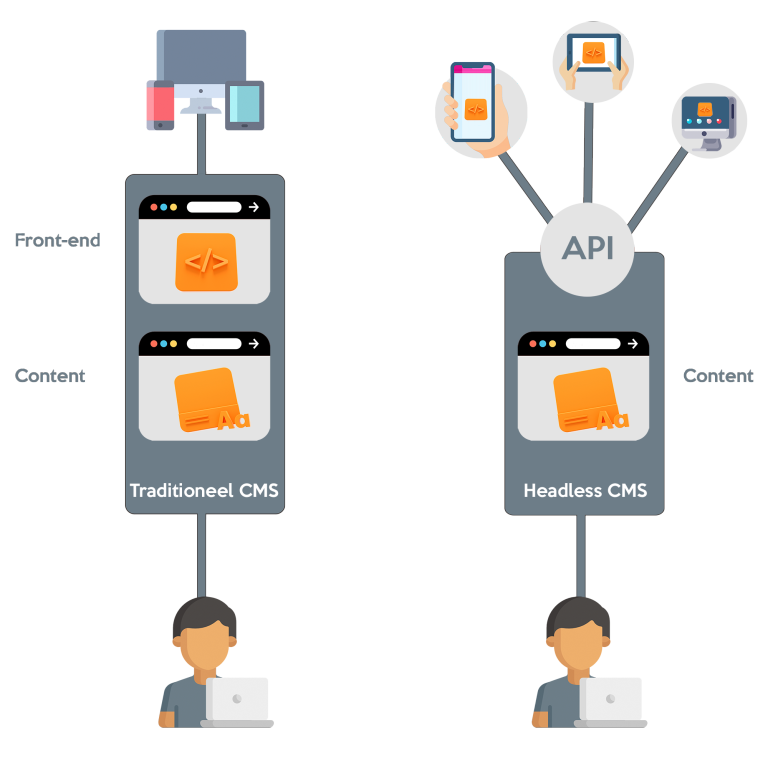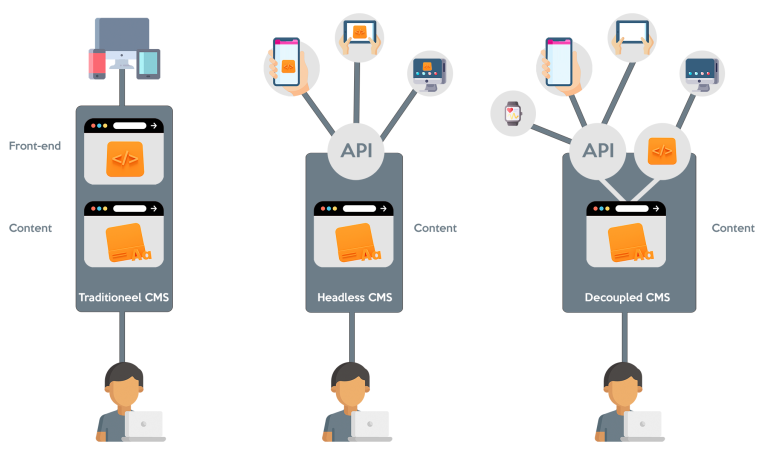Headless CMS
"‘Headless’ is a term that's been popping up more frequently in recent years. If you’re not yet familiar with it, this page is worth a read because ‘headless’ is changing the way we approach content management."
Headless CMS vs Traditional CMS
There's a good chance that you're currently using a traditional content management system (CMS) within your company. There are countless CMS platforms that help you manage website content. Plate also offers a multisite CMS, where we’ve made content management entirely visual.
Traditional CMS
The strength of a traditional CMS is that it allows you to manage both content and the front-end — how the website looks — from a single environment. Content is always tied to the form you give it, providing a ‘website-builder’ or ‘inline editing’ experience when creating a page.

Headless CMS
In a traditional CMS, content (back-end) and front-end are intertwined, whereas a headless CMS separates these two components. In the back-end, you organize information in models, and with APIs, you can direct this information to the appropriate channels (website, apps, digital displays, etc.). This way, a single product in your headless CMS can appear in multiple places in different formats, making it highly efficient since the same content doesn’t need to be added separately in multiple locations.
With a headless CMS, you have complete freedom on the front end to set up your channels. You are not limited by the CMS you use, allowing you to employ modern front-end frameworks like Vue.js, Angular, or React to create the ideal front-end solution for your client.
In this Dutch video, Jeroen Gouw from the digital agency Strangelove explains the added value of headless.
Decoupled CMS
Another CMS variant you often encounter is a decoupled CMS. A decoupled CMS sits somewhere between a headless CMS and a traditional CMS. In a decoupled CMS, the back-end and front-end are separated by an API, giving you the flexibility to create a tailored experience for an app or another channel.

This is Plate's Headless CMS
Smart Content Reuse Through Granular Structuring
Every Content Editor dreads repetitive tasks and managing content in multiple places. With an intelligent editor, this problem becomes a thing of the past. From within the editor, you can easily access and reuse previously structured content. New content can also be structured with a single action, making it reusable across pages without needing updates in multiple locations.
Delta also proactively helps to filter out incorrect information. For example, if your website mentions that your company has 1,400 clients but one page mistakenly says 1,300, Delta detects this potential discrepancy and prompts you to verify and standardize it across the site. So, if you later reach 1,500 clients, you only need to update it once, and Delta will take care of the rest.
The Benefits of Headless Without the Drawbacks
While traditional headless systems allow for the separation of front-end and back-end, offering flexibility for developers, they often leave content editors struggling with complex interfaces and limited control over content presentation.
Add content from a visual environment (for example, by creating a page directly), or start within a structured content model. Additionally, unstructured content can always be intelligently organized within your content model, giving you full control over your content.
This way, we combine the flexibility of headless with an intuitive, user-friendly interface for content editors, enabling smart content (re)use without being restricted by rigid structures or technical limitations.
Simpel: Zero-Learning Curve
Delta is as easy to use as editing a website in an inline website builder, but under the hood, there’s much more going on. You get the power of a serious CMS without the hassle of complex interfaces.
We’ve designed Delta to accommodate both content editors who prefer creative freedom and those who favor structured content. This way, everyone can achieve content success in their own way, effortlessly and effectively.
AI and ML ready
With Delta, your content is no longer tied to a single page but dynamically connected based on topics, relationships, and context. This allows algorithms to analyze more easily, discover trends, and present relevant content. The result? Improved insights, more efficient content management, and real-time personalization for users.
By organizing your content this way, you make it future-proof and ready for integration with AI and emerging technologies.
Multi-Channel Content
Multi-channel content distribution is the foundation of any headless CMS, but what makes Delta unique is the ability to reuse the same content within a smart inline editor. This allows you to craft each experience uniquely while still managing content centrally. It means you only need to make changes once, without having to update numerous locations.
With Delta, you can connect any front-end you choose, giving you complete control over both content and user experience, regardless of platform or channel.


